Chicken × Rabbit
Mammalian Hybrids
|
Sir, to leave things out of a book, merely because people tell you it will not be believed, is meanness.
—Samuel Johnson
|
 It's well known that rabbits will mate with hens. Source
It's well known that rabbits will mate with hens. Source
Note: Any claim that hybrids can actually be produced from this disparate and poorly documented cross would require confirmation from a specimen.
An alleged chicken-rabbit hybrid was pictured (see photograph, and its caption, below) on page 358 of the July 1898 issue of The Strand Magazine, a monthly magazine founded by George Newnes, composed of short fiction and general interest articles:
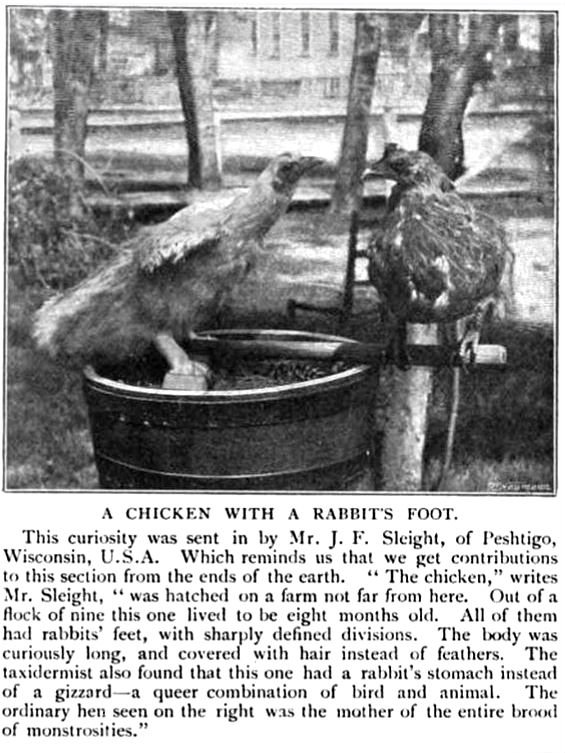
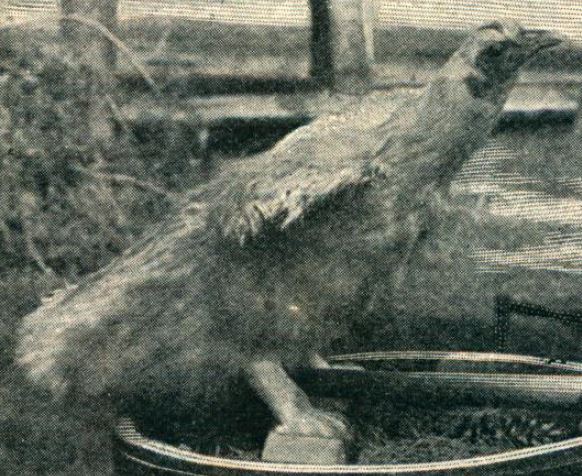 The alleged chicken-rabbit hybrid from the same picture as above, but scanned at high resolution directly from a hard copy of Strand Magazine (July 1898, p. 358).
The alleged chicken-rabbit hybrid from the same picture as above, but scanned at high resolution directly from a hard copy of Strand Magazine (July 1898, p. 358).
It seems that the alleged rabbit-chicken hybrid shown is a stuffed specimen, which had died a few years before (see 1891 article quoted below).
James F. Sleight was Peshtigo’s representative to the Wisconsin State Assembly.
More information about this case appeared a few years before in the issue of the Mineral Point, Wisconsin, Iowa County Democrat (Apr. 10, 1891, p. 1, col. 8):
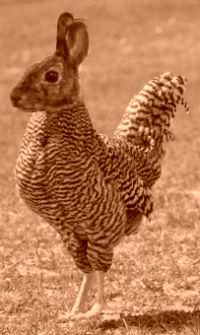 A reconstruction of the creature described in the report at left.
A reconstruction of the creature described in the report at left.
In addition, a brief notice about a chicken with the head of a rabbit appeared on the front page, column 7, of the November 22, 1901, issue of the Marshall County Independent, a newspaper published in Plymouth, Indiana (source). It reads as follows:
Compare the reports above to another report recorded on this website, about a rabbit-owl hybrid.
A rabbit-chicken breed?
The Silkie breed of chicken (shown above) has “feathers” like hair, and five toes (unlike other chickens). In older works, it was often alleged that this breed was originally produced by crossing rabbits with chickens (access a list of such works >>). It was known by the Latin name Gallus lanatus (“wooly chicken”) and in German as the Wollhuhn (“wool hen”). Note, however, that silkies do not look like the Peshtigo bird (pictured at the top of this page), which, if it is a hybrid at all, would represent an F1. The actual origin of the breed is unknown, but since silkies were mentioned in very early works (e.g., by Marco Polo), it is at least conceivable that they represent a breed anciently derived from a rabbit-chicken cross, and that their true origins have simply been lost in time.
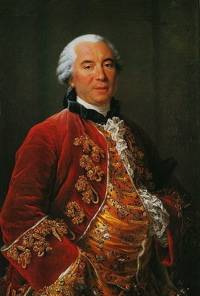 Buffon
Buffon
In 1766, the French naturalist, the Comte de Buffon, received repeated letters from two men in Bruxelles who claimed to have in their possession a rabbit-chicken hybrid. But without investigation he rejected their claim as utterly outlandish (Nouveau dictionnaire d'histoire naturelle, s.v. Coq a duvet). Scientists often summarily reject the possibility of hybrids when the perceived degree of difference between the proposed parents is large, and therefore refuse to investigate them. This widespread attitude makes it difficult to collect definitive empirical data on, or disseminate knowledge about, putative distant hybrids, which in turn largely prevents scientists from encountering any information that might change their minds. Catch-22!
Mating between rabbits and chickens
Mating of buck European rabbits (Oryctolagus cuniculus) in captivity with domestic hens (Gallus gallus) has been described by various authors and actually captured in videos on Youtube (e.g., Video #1, Video #2), an excerpt of one of which is shown at the top of this page. Cases of a rooster mating with a doe rabbit either do not occur or do only rarely, which is not surprising given that many crosses are non-reversible in this way.
Such behavior seems to have been of more interest to early naturalists than to scholarly observers of the modern day. Johann Friedrich Blumenbach (1752-1840), the German physician, naturalist and physiologist, says one of his professors, Christoph Gottlieb Büttner, had “often” observed such behavior (Blumenbach 1776, p. 13). And the eighteenth-century French scientist René-Antoine Ferchault de Réaumur (1683-1757) provides a detailed description of copulation in captivity between a buck rabbit and a domestic hen (De Réaumur 1750, pp. 450-456; 1751, pp. 339-357; Zirkle 1935, p. 171). In fact, in their dissertations written under the supervision of Carolus Linnaeus, Johan Johansson Haartman (1756, p.61) and Nils Ericsson Dahlberg (1788, p. 383), two students of Linnaeus, say de Réaumur actually reported the silkie breed of chicken (“Gallus lanatus,” discussed above) to be derived from this cross. Thus, Haartman states that
And Dahlberg states that
Neither Haartman nor Dahlberg cite a specific publication of de Réaumur for these claims, but it is certainly true that he published a lengthy description of his experience observing a buck rabbit mating with a hen. The following is from the original account (de Réaumur 1750, pp. 450-453):
 de Réaumur
de Réaumur
The whole town of Paris was some years ago full of amours far stranger than those of a duck and a cock, viz., of the amours of a hen and a rabbit. The Abbe de Fontenu…informed the academy of sciences of what passed in the house of his brother, where he lives, between a hen and a rabbit: he informed them of the strong inclination which this ill-sorted couple of animals had contracted for each other, and which was such that the rabbit behaved with the hen as he would have done with his doe, and the hen let him take as much liberty with her as she would have allowed to a cock. The academy judged this fact to be one of those which ought never to be credited, unless it is certain that they have been seen by a discerning eye. The Abbe de Fontenu is one of that sort: but he did not assert the copulation of the rabbit with the hen upon the testimony of his own eyes, he only attested it upon the report of all the servants in the house; as the coachman, the footmen, the cook, and others, all of them not much used to make observations, who pretended they daily saw in a yard where the rabbit and the hen lived together, things which the Abbe de Fontenu was not near enough to observe from the window of his study. I no sooner had hinted to him that I would be very curious to have the hen and the rabbit in my possession to assure myself with my own eyes of the reality and the degree of the liking they had taken to one another, but his kind disposition towards me, of which I am very proud and of which he has given me many proofs, made him promise me without the least hesitation that the two animals would be at my house the very next day.
The rabbit and the hen were accordingly brought to me the day after, which was the twenty-fourth of June: I lodged them in a place where I could conveniently often observe them without interrupting them: it was in a wardrobe which is behind my study and in which I could see all what passed without entering into it. This wardrobe has a large, pretty low window which looks into my garden. They seemed to me perfectly indifferent to each other to the twenty-eighth of June, and it is likely the change of place had disconcerted them and taken up all their thoughts: on that very day at about half an hour after five in the morning, I saw the rabbit draw near the hen, placing his body along one of her sides a moment after, having his hinder paws on the ground, he jumped with the agility of a rabbit, and put the fore-part of his body on the back of the hen, part whom he laid hold of with his fore-paws, at the root of both her wings; he next drew the lower part of his belly as near as possibly he could to the hen’s hinder parts, and gave that part of his body small quick motions, the intention of which was plain enough. He was not allowed to remain in that posture but a very short time. The hen was not disposed to answer his caresses: his forelegs were but a little folded, she went forward and escaped from him.
On the twenty-ninth, I observed no courting on the part of the rabbit, I say of the rabbit, for the hen always behaved like a modest hen; but on the thirtieth, and at half an hour after five in the morning as before, I began to observe the same scene I had beheld on the twenty-eighth which was repeated several times. The rabbit had just eaten a lettuce leaf after having rubbed his paws one against the other, and wiped his chops with them. He went to his hen, and was no sooner by her, but he swiftly jumped with the fore-part of his body on her back; but before he could have time enough to hook himself upon it, the hen escaped the embrace: she was just then in the middle of the small room and ran under a chair The amorous rabbit followed her thither and notwithstanding the cross-bars of the chair-frame, which rendered the compass which the hen was within very narrow, he found means to lay his fore-paws on her back; she escaped a second time from him, and kept quite close to the wall of the window clapping one of her sides against it. The rabbit directly took advantage of a position in which it was become more difficult for the hen to escape him, he quickly jumped upon her: she shewing the same desire to resist him, and the projection of the window not leaving her liberty enough to fly away, she had recourse to force, she turned her head to peck the lips of the rabbit three or four times, which he indeed took not for caresses, it having quite another aspect, so that he directly quitted his hold and went off: he nevertheless paid a little more for his coaxing, and the hen pecked his forehead three or four times more. Her attacks calmed his passion. He remained quiet by the hen, and even let her go from him without following her, and went himself about the room. About half an hour after, the rabbit having eaten a lettuce leaf seemed to have forgot the ill-usage he had met with; he drew near the hen again, and repeated his tender pursuits, which she seemed not more disposed to comply with than before. He in vain was able to mount her three times running, she never would permit his continuance in that position: to get rid of him she got upon a pretty low stool, he was there almost as soon as she, and made new attempts that were not more successful than those he had made when she was on the ground.
The rabbit gave over pursuits which had availed him so little, and remained quiet for about an hour after which his tender fits came on him again; about seven o’clock, he went up again to the hen who had clucked a little before but not very loud: she was in the middle of the room when he placed the fore-part of his body upon her back with a new ardour; he perhaps found means then to hook himself better there than he had done hitherto, or perhaps the hen had no longer the same disposition to run from him: she nevertheless made a few steps forward, but slowly, and with her legs somewhat bent. The amorous rabbit kept his hold and remained where he was, but then the moment of her being conquered was come; she squatted herself as all hens do, which after having run away from the cock, consent at last to admit his caresses; she let the rabbit put himself in what position he pleased; he left his two hinder-paws on the ground, and laid his body all along the back of the hen, whose tail was removed to the left side by the pressure of the thighs of the rabbit; the hen in short became a perfect doe to him; he remained active upon her four or five times longer than a cock would have done.
But was the copulation as complete as that of a hen with a cock, or of a rabbit with a doe? This I indeed know not: all I know is that what passed between them proved sufficient to cool the rabbit: he not only let the hen alone for above two hours together, but he even seemed to want nothing but rest. He passed these two hours upon the above-mentioned low stool, perfectly motionless, and without changing his place.
By the same author: Handbook of Avian Hybrids of the World, Oxford University Press (2006).
Most shared on Macroevolution.net:
Human Origins: Are we hybrids?
On the Origins of New Forms of Life
Mammalian Hybrids
Cat-rabbit Hybrids: Fact or fiction?
Famous Biologists
Dog-cow Hybrids
Georges Cuvier: A Biography
Prothero: A Rebuttal
Branches of Biology
Dog-fox Hybrids
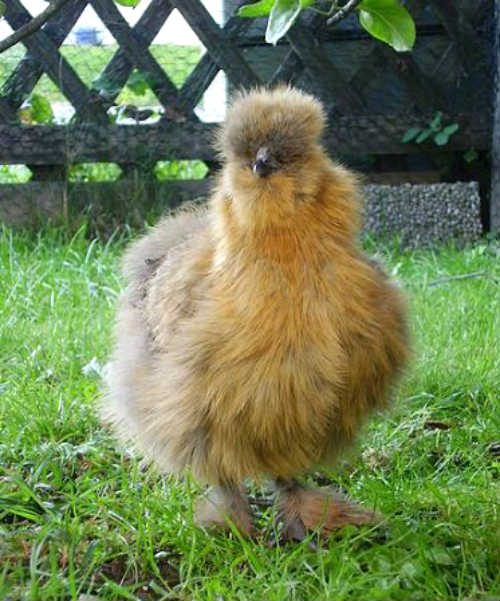 Image: Boris Bartels
Image: Boris Bartels